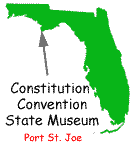|

Reservations for
Florida State
Parks are now
made through
Reserve America,
toll free, at
1-800-326-3521
|
CONSTITUTION CONVENTION STATE MUSEUM
The Constitution Convention State Museum is the site of Florida's first state convention. The Constitution Convention as well as the vanished city of St. Joseph are featured in the museum at Port St. Joe.
HISTORY
More than 150 years ago, St. Joseph was selected over Tallahassee
(the territorial capital) as the site of the state's Constitution
Convention because of antagonism between East Florida and Middle
Florida and because of the efforts of boomtown promoters. St.
Joseph, created in 1835, was a boom town when it competed with
the town of Apalachicola as a trading port. Its population
quickly reached 12,000. By 1840, it was clear that the city of
St. Joseph could not compete commercially with Apalachicola; and
the town laid aside its role as a commercial metropolis and
served as an attractive pleasure resort. In the summer of 1841,
yellow fever reached epidemic proportions in the entire
territory, and St. Joseph was especially hard hit. The
population declined from already fewer than 6,000 to 400 in less
than one year. Many of the deserted houses were dismantled and
shipped to Apalachicola for reconstruction. Some still remain
there today. The hurricane of September 1844 completely
destroyed what remained of the town. The only thing left was the
town's cemetery - a grim reminder of a small town's struggle to
compete.
During this nine-year period, work to bring Florida to statehood
continued. Although Florida had been an American territory since
1821, many Floridians, especially those living in prosperous
Middle Florida, had long favored a change from territory to
statehood. On the other hand, East and West Floridians opposed
statehood because of costs, feeling that Florida was too poor to
assume the financial burden of a state government. The first of
Florida's five constitutions was drafted by a convention that met
on December 3, 1838. By working diligently for 34 days, the
elected delegates hammered out a framework for Florida's future
and finished their work on January 11, 1839. The Territorial
Legislative Council had called the convention without
congressional authorization after a referendum election in 1837
showed a territory-wide majority in favor of statehood. On the
same day the convention voted to submit the completed
constitution to the people for ratification, it submitted to
congress the formal application of the people of Florida for
admission to the Union. This proved premature. The new
constitution squeaked through the referendum by only 119 votes.
During the next six years, the beleaguered Legislative Council
successfully petitioned Congress for immediate admission to the
Union, for indefinite postponement and for division into two
territories. The question was finally resolved when congress
passed an act admitting Florida into the Union on March 3, 1845,
as the 27th state. Florida entered the Union with Iowa, in line
with Congress' practice of admitting Northern and Southern states
in pairs.
MUSEUM
A Constitution monument was erected on the grounds in 1922 and
bears the names of the convention delegates engraved in marble.
A museum building was added to the 13.5-acre site and opened to
the public in 1955. A self-guided tour will lead you through the convention hall where the convention setting is recreated with
life-size delegates. Audio-animated mannequins portray Territorial Governors Robert Reid and William P. Duval, Senator
David Y. Levy and Attorney Thomas L. Baltzell. The museum
visitor center is open from 9 a.m. to 5 p.m. Thursday through
Monday, except Thanksgiving, Christmas and New Year's Day. A
nominal fee is charged for museum visitors six years of age and
older. Special interpretive programs and tours designed for
groups can be arranged.

Constitutional Convention State Museum is located in Port St. Joe, off U.S. 98.
For information, contact:
Constitutional Convention State Museum
200 Allen Memorial Way
Port St. Joe, Florida 32456
(850) 229-8029
View Larger Map
|




